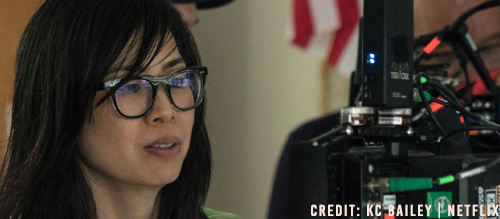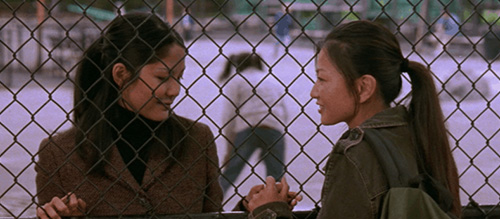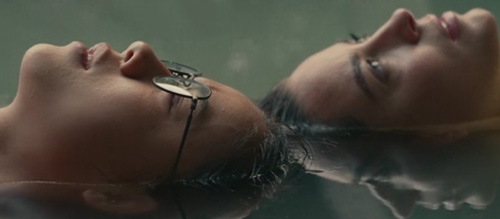In Defense of the Happy Ending: Alice Wu and LGBTQ+ Movies
Romantic comedies are a promise between the filmmaker and the audience. There are certain beats the film must follow: a meet-cute, a swoonworthy first kiss, an argument, a deep soul-searching montage set to an indie pop song, and an inevitable reconciliation that blends into a happily ever after. It’s easy to call the genre stale, given the fact that audiences know how these movies will end before they even begin. Of course, there are films that add a new, lively spin to the romantic comedy (newly-released Fresh is an example), but there’s comfort in watching a movie where there are no unexpected detours.
There’s a lot to say about romantic comedies and their impact on young people learning what a healthy relationship looks like. Noah hanging from the Ferris Wheel in The Notebook immediately comes to mind as more of a red flag than probably originally intended. Romantic comedies exist to encourage people to put themselves out there and fall in love. That’s all well and good when there are happy endings on the horizon. If someone has seen a character who looks/acts/feels like themselves end up happily time and again, they start itching for those new spins on the genre. But what about the people who have never gotten to see themselves in the romantic comedy world? For so long, Hollywood has made it seem like only white, cisgender, non-disabled, heterosexual people fall in love. Usually, when the focus is on someone who doesn’t fit into that box (whether they be queer, transgender, person of color, etc.), the story is much more melancholic. These movies focus on hardships, and the person ends up alone rather than riding into the happily-ever-after sunset.
Specifically in LGBT movies, there are many examples of films that don’t have a happy ending. In fact, there is a plethora of examples of queer women dying in tv and movies, usually immediately after coming out or finally having a romantic moment with a partner. All of these tragic demises and their overabundance across genres can make the young, queer person watching these movies at home feel isolated. These people are likely in search of representation as a means of understanding themselves, but instead they’re being told over and over again that the only outcome for a queer person is being alone and/or dying. Whether the filmmakers means it or not, these movies are essentially teaching LGBT people that there isn’t a happy ending waiting for them. It’s easy to say that outlook is blowing things out of proportion, but so much of a teenager’s understanding of the world comes from popular culture. The inability to see someone who looks or loves like them be happy and desired is detrimental to their self-esteem and self-worth. All of a sudden, their future and potential are limited.

That’s why writer/director Alice Wu’s films, Saving Face and The Half of It, and her decision to give her lesbian Chinese-American characters happy endings are so radical. It’s not a decision that was taken lightly when Wu was making Saving Face in 2004. Executives told her the story was “too happy” and wanted her to make the main character, Wil (Michelle Krusiec), white so Reese Witherspoon could play the part. Wu held her ground on all fronts and created a romantic comedy that has stood the test of time. Many queer women point to it as the first LGBT movie they saw that had a happy ending.
Wu has described Saving Face as a love letter to her mother. It centers on Wil, a twenty-something surgeon who is trying to balance her life with the expectations of her widowed mother, Gao (Joan Chen), and the rest of her family. Her mother insists that Wil attend a weekly social gathering in Flushing, NY, that she jokingly calls “Planet China” because that’s where her extended family lives. At one of these events, Wil runs into Viv (Lynn Chen), a childhood crush who is now a prima ballerina. The two reconnect outside these weekly events, but Wil’s life is turned upside down when she comes home from work one night to find Gao at her front door. Wil’s grandfather has kicked her mother out of the family apartment in Flushing because she’s pregnant and unwed.
There was a sixteen-year gap between Saving Face and Wu’s spiritual sequel, The Half of It. This time, the story is set in the small, fictional Pacific Northwest town of Squahamish and quiet, nerdy high-schooler Ellie Chu (Leah Lewis) is the focus. It’s hard not to think of Ellie as the younger version of Saving Face’s Wil. They share the same awkward charm, endure strained parental relationships, and have trouble vocalizing their feelings for their crush. Ellie’s crush is Aster Flores (Alexxis Lemire), a popular girl in school and the town deacon’s daughter. Also crushing on Aster is football player and heir to his family’s sausage company fortune, Paul Munsky (Daniel Diemer). Ellie makes money to support her widowed father (Collin Chou) by writing essays for her classmates. Paul asks Ellie to write love letters to Aster for him because he doesn’t have a way with words.

One of the most exciting aspects of Saving Face was Wu’s choice to show a parent’s ability to change and fully embrace their child’s identity. Gao knows that Wil is gay, but tries to set her up with new men every week. By the end of the movie, through Gao’s experiences with Wil and the growth of their relationship, Gao orchestrates the reunion of Wil and Viv. A scene in the beginning of the credits also shows Gao asking the quintessential parental question to Wil and Viv, “when am I getting grandchildren?” As annoying as that question may be, it’s a milestone, a validation of sorts coming from Gao. It marks the growth she’s had throughout the movie.
Wu seems to take delight in using rom com tropes in unexpected ways, expanding the definition of what is considered romance. Between the two films, she has had a character stop a wedding and a proposal, chase down a plane and train, and give a sweepingly romantic speech. Not all of these moments are between lovers. Some are scenes between children and parents, or friends. Not only does Wu’s work seek to show the importance of romantic happy endings, she celebrates the effort that goes into all relationships. To borrow Wu’s own words from The Half of It, “Isn’t that what love is? How much effort you put into loving someone?”
Of Wu’s two films, Saving Face is the more by-the-book romantic comedy. Wil and Viv’s relationship is the heartbeat of the movie and a pure delight to witness. The spark when they meet again as adults, the flirty notes Viv tapes to the vending machine where Wil works, the shyness of their first kiss, and the heartache when things don’t go the way they wanted. Wil is nervous about fully letting herself be in a relationship with Viv and holds herself back. When Wil goes to Viv’s apartment for the first time, as a bit of an icebreaker Viv mentions how she works with Arts Alliance and is teaching kids how to fall without hurting themselves. While an important skill for dancers to know, it also mirrors Wil’s hesitation to become fully present in the relationship. There is a way to fall in love without hurting oneself; by committing wholeheartedly and leaving nothing on the table. Sure, if the relationship doesn’t work out it will hurt, but that’s nowhere near the level of anguish Wil would feel if she didn’t put everything she had into letting Viv know how she felt. This theme of effort comes up again in The Half of It.

Unlike other LGBT films where a queer character’s personality begins and ends with their sexual identity, Saving Face and The Half of It give a fullness to their lead characters. The ending of The Half of It is a different kind of happily ever after. Instead of the girl getting the girl and the two of them riding off into the sunset together, it’s each of the individual characters getting their own happy ending. These endings could only be achieved because of the tangled web that was woven earlier in the movie. Aster wouldn’t be applying for art school, Ellie wouldn’t be going to college out of state, and Paul wouldn’t be starting a new sausage dynasty without the Cyrano de Bergerac-like relationship between Ellie and Paul. It’s a love story where everyone gets what they need, even if it’s not what they thought they wanted at the beginning. These revelations and the characters’ individual growth are a direct product of the effort and attention the characters give to each other.
For many people, there’s nothing remarkable about a happy ending. It’s simply what is expected at the end of a certain type of movie, but it’s more than that for underrepresented people. It’s reassurance of a better future, validation of their identity, and a radical declaration of joy.
Written by Tina Kakadelis
You can support Tina Kakadelis at the following links:
Twitter – @captainameripug
Bio Site – tinakakadelis

